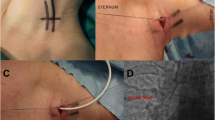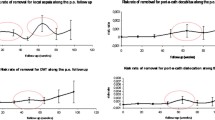Abstract
Introduction
The cannulation of suitable peripheral veins may be a very painful experience. Implantable venous access systems have to some degree relieved this problem and help to provide an improvement in terms of quality of life.
Material and methods
We have evaluated 560 patients during a follow up period of two years. A low overall complication percentage of 7.32% was seen when using the venous access device.
Results
Complications and treatments were: pneumothorax; portal rotation or infection; catheter infection; embolism and migration; extravasation; partial or total obstruction of the device; rupture of the catheter or the membrane.
Conclusions
There is no other system that allows repeated venous access on such a long term basis. Placing the devices completely under the skin allows the patient to conduct a normal life style, and its maintenance does not need any special care, with the exception of the monthly heparinised serum infusion. The preferred option is to insert the catheter through the cephalic vein in the delto pectoral groove.
Similar content being viewed by others
References
Cozar Ibáñez A, del Olmo Escribano M, Moreno Montesinos JM, Jiménez Armenteros F, Quesada Peinado MC. Experiencia clínica con reservorios venosos subcutáneosen pacientes oncológicos. Clin Transl Oncol 2004;6:30–6.
Burbridge B, Krieger E, Stoneham G. Arm placement of the Cook titanium Petite Vital-Port: results of radiologic placement in 125 patients with cancer. Can Assoc Radiol J 2000;51(3):163–9.
Miller LW, Merkle EJ, Hermann V. Out-patient dobutamine for end-stage congestive heart failure. Crit-Care-Med. 1990;18 (1 Pt 2):S30–3.
Tait DL, Obermiller PS, Redlin-Frazier S, et al. A phase I trial of retroviral BRCA 1sv gene therapy in ovarian cancer. Clin-Cancer-Res. 1997;3(11):1939–68.
Wildhaber B, Kistler W, Caflisch U. Experience with Port-A-Cath System in children. Schweiz Med Wochenschr. 2000; 130(20):752–8.
Nostdahl T, Waagsbo NA. Costoclavicular pinching: a complication of long-term central venous catheter. A report of three cases. Acta-Anaesthesiol-Scand. 1998;42(7):872–5.
Ballarini C, Intra M, Pisani-Ceretti A, et al. Complications of subcutaneous infusion port in the general oncology population. Oncology 1999;56(2):97–102.
Myint H, McGregor J, Edwards R, Lucie NP. Spontaneous fracture of the outler catheter of a totally implanted catheter system (Port-A-Cath). Int J Artif Organs. 1994;17(9):505–7.
Ardalan B, Flores MR. A new complication of chemotherapy administred via permanent aindwelling central venous catheter. Cancer 1995;75(8):2165–8.
Whigham CJ, Goodman CJ, Fischer RG, Greenbaum MC, Thornb JI, Thomas JW. Infectious complications of 393 peripherally implantable venous access devices in HIV-positive and HIV-negative patients. J Vasc Interv Radiol. 1999;10(1):71–7.
Barrat C. Mise en place chirurgicale d'un site implantable. Cahiers d'oncologie. 1998; 7(7):273–5.
Silver DF, Hempling RE, Recio FO, Piver MS, Eltabbakh GH. Complications related to indwelling caval catheters on a gynecologic oncology service. Gynecol-Oncol. 1998;70(3):329–33.
Petersen C, Fuchs J, Kotzur A, Strauss G. Zentralvenose Verweilsysteme in der padiatrischen Onkologie aus chirurgischer Schit. Klin-Padiatr. 1998;210(2):65–9.
Burdon J, Conway SP, Murchan P, Lansdown M, Kester RC. Five year's experience of PAS Port intravenous access system in adult cystic fibrosis. Eur-Respir-J. 1998;12(1):212–6.
Armbruster C, Gmeinhart B. Management HIV-infizierter Patienten: Anwendbarkeit von Richtlinien. Ergebnisse einer osterreichweiten Umfrage. Acta-Med-Austriaca. 1998;25(1):21–6.
Groebli Y, Wutrich P, Safa M, Tschantz P, Callawaert G, Piguet D. Utility and complications of permanent venous access devices in oncology patients. J Vasc Interv Radiol. 1999;10(4):463–71.
Author information
Authors and Affiliations
Corresponding author
Rights and permissions
About this article
Cite this article
Sánchez, L.Y., Galbis Caravajal, J.M., Fuster Diana, C.A. et al. Protocol for the implantation of a venous access device (Port-A-Cath System). The complications and solutions found in 560 cases. Clin Transl Oncol 8, 735–741 (2006). https://doi.org/10.1007/s12094-006-0120-y
Received:
Revised:
Accepted:
Issue Date:
DOI: https://doi.org/10.1007/s12094-006-0120-y




